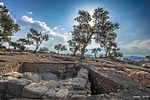National Water Carrier of Israel

The National Water Carrier of Israel (Hebrew: המוביל הארצי, HaMovil HaArtzi) is the largest water project in Israel, completed in 1964. Its main purpose is to transfer water from the Sea of Galilee in the north of the country to the highly populated center and arid south and to enable efficient use of water and regulation of the water supply in the country. Up to 72,000 cubic meters (19,000,000 U.S. gal; 16,000,000 imp gal) of water can flow through the carrier each hour, totalling 1.7 million cubic meters in a day.Most of the water works in Israel are integrated with the National Water Carrier, the length of which is about 130 kilometers (81 mi). The carrier consists of a system of giant pipes, open canals, tunnels, reservoirs and large scale pumping stations. Building the carrier was a considerable technical challenge as it traverses a wide variety of terrain and elevations.
Excerpt from the Wikipedia article National Water Carrier of Israel (License: CC BY-SA 3.0, Authors, Images).National Water Carrier of Israel
77, Emek Izrael Regional Council
Geographical coordinates (GPS) Address Nearby Places Show on map
Geographical coordinates (GPS)
| Latitude | Longitude |
|---|---|
| N 32.774575 ° | E 35.253925 ° |
Address
77
1710801 Emek Izrael Regional Council
North District, Israel
Open on Google Maps









